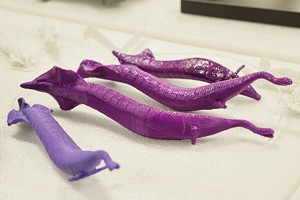
Since its discovery in 1958, the Tully monster has left scientists guessing. Not anymore.
New research shows that the animal which serves as Illinois’ state fossil isn’t related to modern worms or snails, as scientists previously hypothesized. Instead, it had a type of spinal cord and was similar to today’s lamprey.
The discovery puts the Tully monster, which is only found in one spot in Illinois and nowhere else on earth, into an entirely different phylum on the taxonomic tree than researchers expected. It also potentially makes the Tully monster an evolutionary ancestor of humans.
The Tully monster, also known by its scientific name Tullimonstrum gregarium, was up to 14 inches long and shaped like a fat cigar with tailfins, its eyes set on stalks and its mouth at the end of a long proboscis. It lived about 300 million years ago during the Pennsylvanian geologic period, when Illinois was covered by a shallow tropical sea and coastal swamps. Fossils of the Tully monster have only been found at the Mazon Creek fossil bed near the northeastern Illinois town of Morris. The site is on the National Register of Historic Places and has yielded several other enigmatic fossils.
Dr. Victoria McCoy is the lead author of a research paper published March 16 in the academic journal Nature. McCoy was a graduate student in the Department of Geology and Geophysics at Yale University when she and her team analyzed 1,200 specimens of Tully monster at the Field Museum in Chicago. Now an honorary research fellow in the Department of Geology at the University of Leicester in the United Kingdom, McCoy says her Tully monster discovery is especially exciting for her because she wanted to study the animal since she was a child.
“I was interested in it for most of life, and I always wanted to be a paleontologist,” she said. “The Tully monster is pretty well known among paleontologists, and the mystery immediately grabbed me.”
By analyzing the chemical compositions of different specimens and looking at them with an electron microscope, McCoy was able to determine that a light-colored area previously thought to be the animal’s gut was actually a notochord, the type of spinal cord found in fish but not in animals like worms. That makes the Tully monster a vertebrate, likely related to the jawless lamprey fish.
McCoy says the study succeeded because of the strong collaboration between researchers from Yale, the Field Museum, Argonne National Laboratory and the American Museum of Natural History.
Dr. Chris Widga is associate curator of geology at the Illinois State Museum Research and Collections Center in Springfield, which houses dozens of Tully monster specimens. Widga says the Illinois State Museum wasn’t involved in McCoy’s discovery, but he agrees with her conclusion.
“My first thought was that I need to read the original paper, because this is the kind of thing people have gotten wrong before,” he said. “I got my hands on the paper, and yeah, they’ve got me convinced.”
Although the Illinois State Museum is currently not open to the public because of the state budget crisis, the ISM website contains photos and information on its Tully monster specimens and the Mazon Creek fossil bed.
Widga says the last time the Tully monster was studied in depth was in the 1980s, which illustrates the need for research institutions to constantly reexamine their collections.
“Given changes in technology and how we think about things, these types of specimens need to be looked at periodically,” he said. “As we tell potential donors, this stuff basically doesn’t just sit on the shelf.”
Contact Patrick Yeagle at [email protected].
















